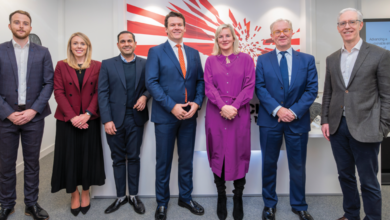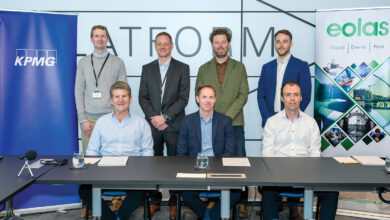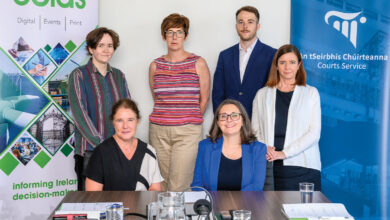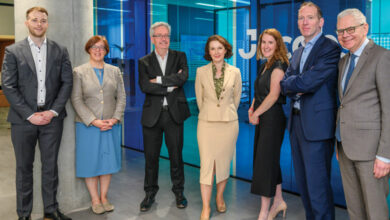How can we accelerate renewable energy deployment in Ireland?
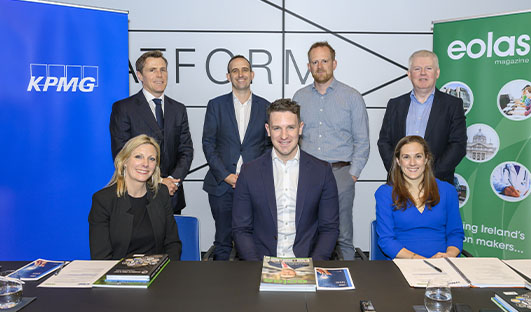
 KPMG hosted a roundtable discussion on renewable electricity development, which is central to the Government’s climate action ambitions.
KPMG hosted a roundtable discussion on renewable electricity development, which is central to the Government’s climate action ambitions.
How has government policy assisted your renewables journey up to this point?
Cathal Hennessy
The energy sector is very regulated because it is a public need. Without regulation, there would be no industry. Without European policy directing national policy, there probably would not be the urgency for national policy to have the impetus to decarbonise the economy. The first significant introductions of onshore wind and hydro on to the grid in the 1990s were very important, but it is the decarbonisation and renewable electricity targets for 2030 that are now driving the sector, which again come from the European framework. The challenge is at a national level, where the targets are strong and robust at governmental level, but when we get down to local implementation, that is where things get stuck.
Val Cummins
There has been a sizeable shift in policy progress, but we started from a very low base. Ireland is a small island nation with a maritime area seven times of its land mass, and we have been very slow to begin the development of our offshore renewable energy. In the last few years there has been an awakening. A key shift was in the Programme for Government when the Government published an ambition for 30GW of floating offshore wind off the west coast. A second point was the target for offshore wind in the Climate Action Plan which has subsequently been upgraded to 5GW. That is really important for getting the supply chain and the sector going. The planning regime for the marine planning has also been vital. They were all important milestones but because we started from a low base, the progress has been relatively incremental, and we still have a huge gap to fill.
James Delahunt
At a high level, overall government policy ambition has been very good in terms of attracting investment interest. In KPMG, we have spoken to nearly 200 potential investors in the last two to three years, and 100 in the last three months. They are attracted by a government that set out a Climate Action Plan in 2019, then the Programme for Government embedded that plan in 2020. Having a Green Party as part of the coalition helped raise climate action ambition and the 2021 Climate Action Plan revised the ambition to 80 per cent renewable electricity. Setting that national ambition, broadly supported by the Government and the opposition parties, is something that provides international capital with a good degree of comfort.
Tara Reale
The promise of RESS and the subsequent confirmation that there will be at least four onshore RESS auctions is what enabled us to develop in Ireland and invest in the country, despite some of the challenges and uncertain economics around solar in the country. Similarly, the Climate Action Plan, the 80 per cent by 2030 target, these have enabled us to build a business case for staying in the country. It is a little bit more challenging as there are no alternative routes to market, but these are still positive as the Government has enabled us to develop here.
Peter Lynch
Our mandate is to deliver 1GW of new onshore wind projects by 2030. That is significant and to get there we had to look at our policy pillars. Fundamentally, they were there in the 2016-2018 period with the underlying EU legislation being transposed into Ireland and the success of REFIT. That example should not go unmentioned: a well-designed structure worked for everybody in the ecosystem, from developers to owner-operators and investors. For those reasons, there is an understanding that the country can do this. The headline pillars are rock solid from a European perspective down into Ireland and all of these things have been important in giving our business the confidence to go forward.
What are the most significant barriers inhibiting renewable energy capacity in Ireland, and what policy changes could overcome these challenges?
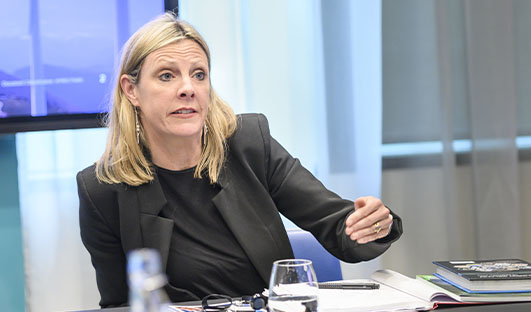
“We can accelerate offshore wind development by looking at hybrid grid connections, whereby two or more generation sources can share a grid connection.” Val Cummins
Cathal Hennessy
Grid infrastructure is the number one risk for all renewable energy deployment. Firstly, the key concern is that ESB Networks and EirGrid do not have the necessary resources to deliver on the 2030 targets and beyond. Secondly, Ireland is unique in that it does not offer firm grid connections. That means you have to factor in dispatch down into your financial model – that can mean 10, 12, even 14 per cent dispatch down for some regions in Ireland and that in turn is passed onto the consumer. That gives a disincentive to invest in the Irish market and that’s not the case in other European markets.
Tara Reale
Grid is also the big issue for us but with a different nuance. Getting the capacity in the first instance is the challenge for us. EirGrid’s onshore transmission plan is based on 1GW of solar PV by 2030. With the focus on offshore wind, we seem to be putting all our eggs in one basket. Offshore generation is certainly an opportunity, but will it be there is sufficient scale by 2030. Whereas onshore wind could be deployed much quicker and there is already a huge pipeline of projects. There is a lot of uncertainty around grid connections. ECP (enduring connection policy) 2.3 is due this September and there has been no announcement if the same type of rollout [of connection offers] will continue into the future. This is a huge concern for us. We are keen to invest in Ireland but it’s difficult to make a business case for that investment with such an uncertain regulatory framework.
Peter Lynch
The issue of resources is a much more fundamental problem. Until now we have just about got by with the existing structure, but it appears to be grinding to a halt. We are talking about doubling our renewable ambition in half the time and the multiple effect of that is critical. When we talk about resourcing, we need to look at the detail. The all-of-government approach makes sense, but resourcing issues go beyond the grid companies. They affect all the main players such as ABP, CRU and the local councils. Resourcing issues go beyond just the head count. It’s about understanding required specific capabilities and skills. This issue is even more difficult as we are asking more and more of these organisations as the industry grows exponentially. Now is a good time to stand back and see what resources we need across all agencies to deliver these ambitious targets.
James Delahunt
The barriers can be grouped into four categories: land; planning; grid; and route to market. The big issue cutting across all these is resourcing and skills within the agencies and also in the wider energy sector in Ireland. We see our clients facing challenges in recruiting quality people to deliver on their own ambitions. For government policy, it is an issue that goes beyond DECC (Department of the Environment, Climate and Communications) to other departments such as Department of the Taoiseach and Department of Enterprise, Trade and Employment.
Val Cummins
We would put grid as the main barrier also. Firstly, on the issue of grid reinforcements and upgrades, there is a lack of confidence in how Shaping Our Electricity Future was arrived at. It’s critical for us as we are looking to land 800MW off the south coast, with 400MW into Cork Harbour. Secondly, the low hanging fruit was ignored in Shaping Our Electricity Future. For example, the west coast was not considered adequately, with no plan to connect offshore wind to existing grid capacity at Moneypoint. Finally, we can accelerate offshore wind development by looking at hybrid grid connections, whereby two or more generation sources can share a grid connection.
Peter Lynch
In terms of leadership, the sector is good at talking to itself. Testimony to this is the recent Wind Energy Ireland (WEI) annual conference, a great event with excellent content, but could be viewed as being too inward-focused. There is a unique opportunity to grasp and a potential threat to avoid with the upcoming REPowerEU proposals, which look as if they will give priority to renewable energy projects across a few fronts. However, if it is too blunt an instrument or poorly introduced into Ireland, we run the risk of disenfranchising certain groups which should participate in the transition process. If that legislation comes through, we need to ensure a correct balance is struck. Without that balance, we will make things much harder for all renewable electricity developments in the longer run and risk opening up a new cycle of legal challenges. We are already seeing aspects of this at a lower level, where local councils are finding it difficult to support county development plans that are future-proofed for climate action. In many cases, the planning regulator is now intervening. Regional planning needs to be implemented and done so properly. While REPowerEU has great potential for the sector, the challenge is that it will require both quick and careful transposition to local law and implementation from there.
Cathal Hennessy
Another barrier is the market. We are a very small electricity market. Renewable electricity from onshore and offshore wind and solar PV most likely is the lowest cost of new generation which drives down the cost of electricity. That is good for consumers but from an investor perspective this damages the signals from the market. To address this we need policy interventions to encourage more investment in interconnection and to facilitate the development of new demand sources for electricity. Most recently, we have seen negative policies towards demand sources of electricity, such as data centres – that is a retrograde step. To facilitate more renewables and more investment in local communities and in Irish supply chains we need more demand. That is a key risk and there is a tipping point where investment signals will stop.
How can Ireland increase its international competitiveness to better secure capital investment in renewables?
James Delahunt
To achieve Ireland’s renewable electricity ambitions, it will require the largest public and private investment into a single sector in the history of the State. This will mostly come from international capital, which is in demand worldwide. From an Irish perspective we need to ensure that we are not complacent about attracting this capital. Capital has been plentiful in recent years but that may be about to change. Some global capital providers have already decided to focus on other markets. Not because Ireland has done anything wrong; it is just that they do not have the bandwidth to cover all markets. From a policy perspective, we cannot take the availability of capital for granted. We need to maintain the market attractiveness to attract capital with policy certainty and clear timelines. We are competing with other jurisdictions where the base case for planning will not be appealed and going to judicial review or An Bord Pleanála. RESS has been good at attracting investment, but we also need a corporate PPA (power purchase agreements) strategy.
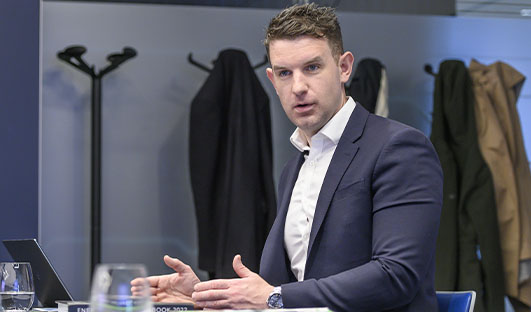
“We need to maintain the market attractiveness to attract capital with policy certainty and clear timelines. We are competing with other jurisdictions where the base case for planning will not be appealed and going to judicial review or An Bord Pleanála.”
James Delahunt
Tara Reale
We need to attract both capital and investors. A key difficulty, particularly for PV, is that RESS is the only route to market. There needs to be alternative routes to give developers certainty. Although each of the different renewable electricity technologies have their own difficulties, a common problem is curtailment. A recent decision on the grandfathering of constraints on the system means that all generation on the system before 2019 has priority over generation after that date. It is a complete unknown for new generation projects and as more new projects come onto to the system the level of constraint will only increase. That is extremely difficult for investors who are taking a long-term view.
I work across the UK and Ireland, and I am asked why is Ireland so expensive? That is due to business rates that are two to three times higher than in the UK and network charges in Ireland are based per megawatt rather than per megawatt hour, which is difficult for technologies with lower capacity factors. EirGrid and ESB have very stringent specifications and getting more so. We all end up paying for over-specified substations that are not necessary.
Peter Lynch
On the positive side, we have the wind resource, and we have a track record of developing it that is the envy of most developed countries. The deployment level of renewable electricity is high but mostly on the shoulders of onshore wind. However, there are a number of impediments to this. The effective transposition of EU laws is important. Firstly, we need to go back to source and ensure any rules set down at an EU level work for Ireland. Secondly, we can do better on the transposition itself, particularly around ensuring regulations are fit for purpose. We need to avoid cliff edges in policy. The road maps have been helpful and RESS, although late, has been good, but the lack of visibility on the next grid connection rounds is not helpful. We need to avoid these policy cliff edges if we are to attract investors into Ireland. Thirdly, we need to avoid own goals. The fact that the wind energy guidelines are still unresolved is a big own goal and creates a fog of uncertainty. Investors and developers coming into this market for the first time are asking which policy framework is relevant. We need clarity as soon as possible.
Val Cummins
The attraction and retention of FDI is a key issue for the sector. There is a high level of interest in investing in renewable energy in Ireland but the experience of investors has not always been positive. For example, Equinor departed from offshore wind last year citing frustration with our regulatory system. We need to be much more competitive in the offshore wind sector, with an industrial strategy to develop the sector in Ireland. We have had success in developing other sectors through the work of IDA and Enterprise Ireland and they should now focus on the renewable energy supply chain opportunity: job creation and skills development. Offshore wind development is being driven by DECC, whereas we need to bring in an enterprise dimension to policy, including a policy on how we develop our ports in relation to the offshore wind sector.
Cathal Hennessy
In RWE, we invest globally and we firstly look for certainty on policy. All policy makers from local councillors all the way up to the Minister have an important role in delivering policy certainty. Without that certainty it is difficult to make investment decisions and it also has a knock-on effect on time frames. In Ireland, the planning time frames are unknown and that is a huge challenge. Secondly, the cost of doing business in Ireland is an issue. The levelised cost of energy (LCOE) for Irish projects is extremely high. We have a higher LCOE than countries, such as Italy, that have much less wind resources. We have the same wind resource as Scotland, and they have a LCOE 20 to 30 per cent lower. The higher costs are due things like to business rates and grid costs. As we move towards a merchant market in future years Ireland will not be competitive.
James Delahunt
Inflation is now an issue for renewable energy project development. In other jurisdictions with both, PPAs or auctions inflation are often applied. This is particularly important in offshore wind where the construction periods are longer. Ireland does not have inflation applied to onshore RESS and it is now a problem in a higher inflation environment.
Which emerging energy technologies will play the greatest role in accelerating Ireland’s renewables deployment?
Val Cummins
In the context of floating offshore wind, work done by MaREI and Wind Energy Ireland indicated that by 2050, we will need 27GW of wind energy. We have an enormous opportunity with regards to our abundant wind resource and floating offshore wind in particular to look at alternative routes to market. In terms of our technology enablers, this is very much about hydrogen production, in particular to get into markets requiring injecting fuel, e-methanol, and green ammonia. We hear about the need for a hydrogen strategy; I would go a step further and say we need an alternative routes to market strategy for floating offshore wind and we need to look at that in the context of floating offshore wind.
James Delahunt
If we fast forward into the mid-2030s onwards, if we develop all of the offshore and onshore potential we have, we are going to have a surplus of generation and we need to find a route to market for that. Hydrogen, green ammonia, and sustainable aviation fuel are dependent on alternative routes to market. Not to get too far ahead of ourselves, we only had the first connected solar plant last month and I do not think that can be categorised as an emerging technology anymore, but in terms of what will play the greatest role in accelerating deployment in the next couple of years, I am excited to see the level of solar and the role it will play.
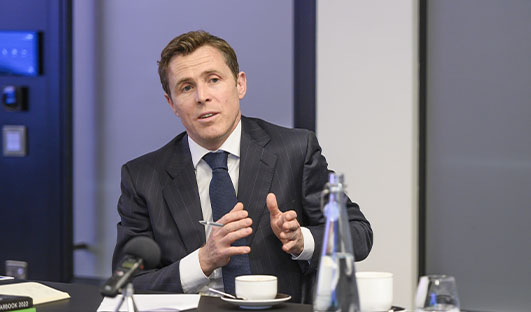
“Now is a good time to stand back and see what resources we need across all agencies to deliver these ambitious targets.”
Peter Lynch
Peter Lynch
It is difficult to figure out what category to put private wires in; it is a new deployment of an existing technology that is going to require smart thinking. Looking across the emerging technologies, we do not have to split the atom. The headline technology signals are being sent to us by Europe, especially in the case of hydrogen. We can define our own smart version of that but closer to home we need something on the private wires and storage side. There are incubators figuring out these technologies around the globe in countries with significant heritage in this space. The more important point is we need to be happy with taking risks on the policy side and to be comfortable with making a few mistakes along the way. That would be better than inertia.
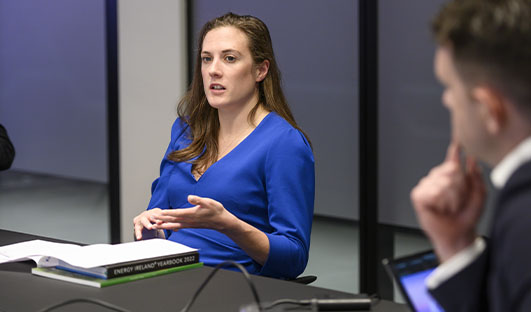
“As we move towards a market with a higher penetration of renewables, we are going to need long-duration storage, which is not quite commercially viable yet. We need to get the supports in place to enable those projects to be there when they are needed rather than this punctuated delay that we would see otherwise.”
Tara Reale
Tara Reale
We need to be forward looking in our subsidies. Right now, RESS, only supports established technologies. As we move towards a market with a higher penetration of renewables, we are going to need long-duration storage, which is not quite commercially viable yet. We need to get the supports in place to enable those projects to be there when they’re needed rather than this punctuated delay that we would see otherwise.
Cathal Hennessy
None of us are technology providers. We deploy other people’s technologies and what is interesting about that is that established technologies that drive to reduce the cost of energy are very much ingrained in those providers. If we look at the last five years, how onshore wind turbines have evolved, three years ago, a 3MW turbine was big, now we are at 6.5MW and what that does is reduce costs to the consumer. The continuous evolution of existing technologies like battery storage and turbines is quite interesting. Hydrogen is an old technology but what is interesting there is the cost coming down; what is emerging is around grid infrastructure and technology deployment to make it more efficient, utilising existing transmission cables and increasing their capacity without the need for more lines.
What one policy area would you like to see action on to accelerate renewable energy in Ireland?
Peter Lynch
The one bit that continues to frustrate is leadership. It is easy to point to other people and ask for leadership but we need to start with asking it of ourselves and making sure that we as industry participants are doing everything we can to go about our work in a transparent way. It has been a feature of the last couple of years that we expect this industry to be the number one, two, or three priority all the time and sadly it is not, and it has never been. We have spoken about security of supply for 15 years, but it has only gained meaning in the last few months. We as an industry need to take more responsibility to encourage politicians to stand up and speak more loudly in support of our sector.
Tara Reale
We do not have a process in our planning system by which you can get what’s termed in the UK a non-material amendment. Given how fast technology is changing, particularly for solar PV, you can’t procure the panels that were on your initial planning application. You then run into difficulties about orientation and certain councils are more flexible, but others are not. That is something of which we need to be more cognisant.
James Delahunt
If we are going to achieve this over the next 10, 20 years, it’s going to impact everyone in the country one way or another. It is important to communicate at every opportunity how important this is; we saw the power of an all-government approach during Covid when everyone was pulling in the same direction. That was a masterclass in terms of communication. When we look at other countries, Denmark for example, people have bought into renewables. Having a strategy around that gives more license to politicians to be bolder.
Val Cummins
I am reminded of the saying “culture eats strategy for lunch”; someone corrected me recently and said culture devours everything in its path. If we are saying leadership is about risk and if the pervading culture is risk-averse, then we won’t have the ability to plan or to be good ancestors, which is what this is about. It is about joined up thinking and having everybody in the room together.
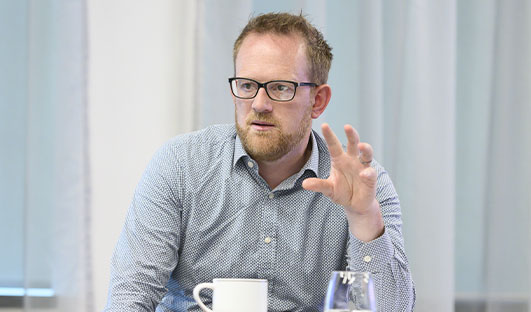
“It would be very positive if each local authority had a megawatt hour target for generation based on the resource available in their geographical area. There is unfortunately a lot of skating around responsibility and if each local government had targets around megawatt hours and CO2 reduction, that would be a big step.”
Cathal Hennessy
Cathal Hennessy
It would be very positive if each local authority had a megawatt hour target for generation based on the resource available in their geographical area. There is unfortunately a lot of skating around responsibility and if each local government had targets around megawatt hours and CO2 reduction, that would be a big step.
 |
Val Cummins
Val Cummins is Managing Director of the Emerald and Western Star floating wind joint venture partnerships between the Simply Blue Group and Shell. She joined Simply Blue as Ireland Projects Director in 2021 following 21 years as a researcher and entrepreneurial academic in University College Cork. Val is also Chair of the Wind Energy Ireland FLOSH Committee (floating offshore wind, supergrid and hydrogen); a council member of Wind Energy Ireland; and a council member and non-executive director of the Marine Renewables Industry Association (MRIA). An Eisenhower Fellow, she is co-editor of the Coastal Atlas of Ireland, published in 2021 and winner of the An Post Best Irish Published Book of the Year and served as co-chair of Future Earth Coasts from 2016 to 2020. |
 |
James Delahunt
James is a Director in KPMG’s Corporate Finance practice and leads the renewable energy mergers and acquisitions and financing service line of KPMG Sustainable Futures. James has advised on over €3 billion worth of energy transactions totalling over 4GW of assets in recent years. He also advises developers and investors on the financing strategy in relation to their asset portfolios. |
 |
Cathal Hennessy
Cathal Hennessy is the Managing Director of RWE Renewables Ireland. Cathal leads the growth of RWE’s renewables business in Ireland, which currently includes onshore wind, offshore wind, and battery storage developments. Having started his career in renewables with the Irish state forestry company Coillte, primarily working on the successful development of their REFIT 2 assets, Cathal joined Europe’s largest solar PV developer, Lightsource bp, establishing their Irish business. He holds a science degree from University College Dublin, and post-graduate qualifications in sustainable energy finance, accountancy, and project management. |
 |
Peter Lynch
Peter Lynch is the CEO of FuturEnergy Ireland, the renewable energy development company which was established in late 2021 and is jointly owned by Coillte and ESB. Prior to this, Peter was the Managing Director of the Renewable Energy Division in the Coillte Group, having previously held senior commercial positions for Mainstream Renewable Power in its European offshore wind division and for NTR plc in its US solar business. Peter started his career as a corporate lawyer with a leading Irish law firm and holds a law degree from UCD and an MBA from INSEAD. He is a director and the current Chairperson of Wind Energy Ireland (WEI). |
 |
Tara Reale
As Head of Business Development for Lightsource bp (LSbp) across the UK and Ireland, Tara Reale is responsible for the overall management of all LSbp development activity in Ireland and leads on the development of the early-stage pipeline in the UK, including the expansion of the business into co-located storage and green hydrogen. Prior to joining LSbp, Tara was a Principal Project Manager for Amey Investments, a Senior Technical and Commercial Adviser for Mott MacDonald, and a Structural Engineer with Aecom. Tara graduated from UCC in 2009 as a civil and environmental engineer, before completing a PhD in asset management at Trinity College Dublin in 2013. |


